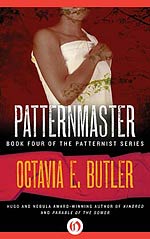
![]() thrak
thrak
9/24/2014
![]()
"Patternists and Clayarks stared at each other across a gulf of disease and physical difference and comfortably told themselves the same lie about each other. The lie that Terray's Clayark had tried to get away with: 'Not people'."
'Patternmaster' is the last book chronologically in the Patternist series, but it is the first book that Octavia Butler wrote. While it may be a little rough around the edges compared to the rest of the entries in the series, all of the major themes and ideas of the series are present and correct. It's clear that many of the ideas that Butler would go on to explore in the rest of the series were already in place from day one. Writing a book set in an unfamiliar future and then extrapolating back how we got from our present day to there is an ambitious and unusual way to go about writing a series. The world of 'Patternmaster' does give Butler a lot to work with though. the book is set in a post-apocalypse future in which the Patternists and Clayarks fight for the Earth, and mutes only exist as programmable slaves to the Patternists. 'Patternmaster' demonstrates that however people change, they are still human, and as such prey to human foibles. Both the psychic powers of the Patternists and the superhuman abilities of the Clayarks are utterly paradigm shifting, and both of these warring tribes of posthumans have set up their own different societies with their own different rules, customs and taboos. However, because these powers naturally set up a power differential, there is still a power hierarchy and so there is abuse of power. Power imbalances dehumanise, making it difficult for Patternists to communicate with mutes or lower level Patternists, or sometimes to even think of them as human. The physical differences and antagonism between the Patternists and Clayarks results in prejudices and misunderstanding. People are still motivated by greed, jealousy and hatred, as well as by love and compassion. Some things about human nature do not change.
'Patternmaster' tells the story of Teray, a young man who has recently graduated from school, and Coransee, a powerful Patternist Housemaster. Both are sons of the Patternmaster Rayal, who is dying from the Clayark disease. Coransee has plans to become the new Patternmaster once Rayal has died, which would make him the most powerful Patternist on the planet, and sees Teray as a potential threat, so he tries various means to put pressure on Teray to allow him to put psychic controls in place so that he can control him. Coransee promises him control of his House after he becomes Patternmaster versus being a servant on the fringes of the House, and steals his fiance. But Teray wants his mental freedom, so he escapes with the help of Amber, a powerful healer, and they attempt to reach Rayal to claim sanctuary from Coransee.
The battle of wills between Teray and Coransee is intense and compelling, and shows up the problem at the heart of the Pattern, which is the same as any power hierarchy: basically, you're stuck hoping that the person in the big seat isn't a dick, and power corrupts. Coransee is much more similar to Doro than Mary, frighteningly more powerful than our protagonist and with a vicious, petty streak to go with it. At the end of the book we learn that Rayal has been holding on to life just long enough for Teray to become strong enough to defeat Coransee, because he knows that Coransee would be a horrible, despotic leader who would make life a misery for all the Patternists.
But the real standout character is Amber. A powerful healer who doesn't owe allegiance to any fixed house, a rarity in the rigidly hierarchical Patternist society, Amber is an African American woman who is openly bisexual. While in some ways, with her strong will and independence, she is a prototype for Anyanwu/Emma, but whereas the latter character is ultimately defined by the compromises she has to make, Amber finds a way of living on the fringes of the repressive society she's stuck in without compromising her ideals. Coransee tries to hold her against her will, leading to the grimmest part of the book, but together with Teray she is able to defeat him and to escape his poisonous influence. We never get to find out if Teray is able to shape the hierarchy of the Pattern into something fairer, or whether there is any possibility of real communication and understanding between the Patternists and the Clayarks, but with Teray in control rather than Coransee, at least there is hope.
http://goldenapplesofthewest.blogspot.co.uk/2014/09/octavia-e-butler-patternist-series-1976.html